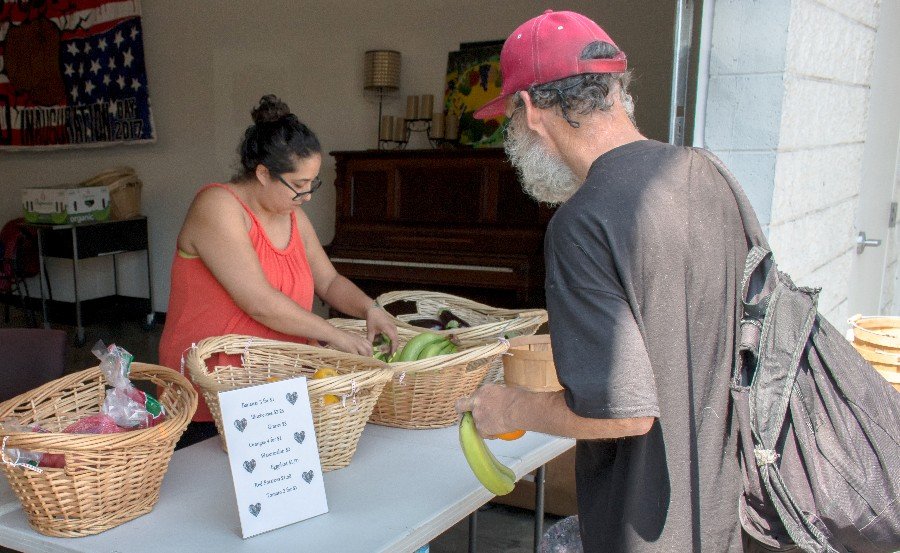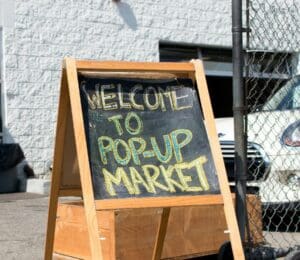Labor & Economy
Organic Oranges for the Homeless? Bringing Good Food to Skid Row
Not eating well sparks a cascade effect in anyone, but the effect is especially pronounced among a homeless population experiencing high levels of stress, mental illness, substance abuse and all the pains that accompany the aging process.

Poor nutrition is the rule among those experiencing the most extreme form of poverty. According to a Harvard Medical School study, a third of the U.S. homeless population is obese.
An organic farmers’ market opening up in the poorest neighborhood in Los Angeles might be taken as a sign the rent there is about to go up. But on Skid Row it’s a useful a reminder: The poor also need and desire good food — and even those with the least to lose, materially, care about their physical well-being.
“It is not something that people probably think of in this community,” said Ariana Alcaraz, an organizer with the Los Angeles Community Action Network (LA CAN), a homeless advocacy group. “‘Oh, where am I gonna get my organic food?’” But it’s something Alcaraz and LA CAN thought the city’s homeless should start thinking about.
Since August 3, LA CAN has been running a small market out of a garage in the group’s Skid Row office, selling oranges, tomatoes, grapes, potatoes and eggplants — all organic. Most customers are homeless or are struggling to avoid falling into a life on the street, but Alcaraz said the market has attracted “some yuppies” too.
“A big part of our work is ultimately education about the importance of organic produce,” Alcaraz added. That education includes teaching people who may not know how to cook how to consume it, even if they don’t have a stove.
Just over 50 people came the first day of the market, which builds on an existing food delivery program and complements another market in a nearby housing project.
 Terry, a Skid Row resident for “the last few years” who declined to give his last name, said it was a welcome addition to the neighborhood. “The body runs like a car,” he said. “Put good fuel in it and it’ll run better.” But it’s hard to find good produce anywhere on Skid Row, “and a lot of these places don’t take food stamps,” he said. “They do here. And that’s good. Good prices, too.”
Terry, a Skid Row resident for “the last few years” who declined to give his last name, said it was a welcome addition to the neighborhood. “The body runs like a car,” he said. “Put good fuel in it and it’ll run better.” But it’s hard to find good produce anywhere on Skid Row, “and a lot of these places don’t take food stamps,” he said. “They do here. And that’s good. Good prices, too.”
Poor nutrition is the rule among those experiencing the most extreme form of poverty. People living on the street “are more likely to buy inexpensive, low-nutrient but high-caloric foods,” according to a a Harvard Medical School study, with researchers finding that a third of the U.S. homeless population is obese.
While many groups distribute food in areas with large homeless populations like Skid Row, often that food is of the “comfort” variety. In 2013, researchers at the University of California, San Francisco found that free meals — which “often serve as a primary food source for adults living in poverty, particularly the homeless” — provided “too little fiber and too much fat,” and were “below target for potassium, calcium, and Vitamins A and E.”
And for those cooking in their makeshift homes, convenience stores are unlikely to offer anything healthier than an onion or potato that has seen better days.
“Where I live, they’ve been taking stores from us,” said Lydia Trejo, who was staffing the LA CAN market and lives in an apartment on Skid Row. One store that used to sell produce, she said, is now a bar.
Not eating well sparks a cascade effect in anyone, but the effect is especially pronounced among a population experiencing high levels of stress, mental illness, substance abuse, and all the pains and illnesses that accompany the process of aging.
“There are people in the area that have physical conditions, such as diabetes and other ailments, where their diet can really promote change,” said a man who introduced himself as Mr. Pancake and a community liaison for LA CAN. “They feel more healthy,” he said. “Healthy eating leads to a healthy mind. That’s what we’re really promoting.”
There’s also now a garden on LA CAN’s roof, though it doesn’t yet produce enough food to sell. For now, it’s primarily a learning experience.
“None of us have ever managed a rooftop garden,” said Matt Horns, an LA CAN volunteer during a tour of it. “Lots of trial and error — lots of errors.” He showed a lettuce plant that had all but withered away and had attracted aphids. But mistakes are teachable moments, and on the roof those buying food downstairs can learn how to grow tomatoes, melons, squash, carrots, raspberries and peppers at home. And those aphids attracted ladybugs, making the garden healthier as a whole.
“We set this up to engage our produce customers — to get them engaged in growing produce,” Horns said. “We consider it a community garden, but envision a gardening community.”
The vision is not just better nutrition, but sustainability and empowerment for an oft-dependent, disenfranchised community on Skid Row. Buy a tomato this week, the hope is, and you may just decide to plant one the next.
Copyright Capital & Main
-

 State of InequalityApril 4, 2024
State of InequalityApril 4, 2024No, the New Minimum Wage Won’t Wreck the Fast Food Industry or the Economy
-

 State of InequalityApril 18, 2024
State of InequalityApril 18, 2024Critical Audit of California’s Efforts to Reduce Homelessness Has Silver Linings
-

 State of InequalityMarch 21, 2024
State of InequalityMarch 21, 2024Nurses Union Says State Watchdog Does Not Adequately Investigate Staffing Crisis
-

 Latest NewsApril 5, 2024
Latest NewsApril 5, 2024Economist Michael Reich on Why California Fast-Food Wages Can Rise Without Job Losses and Higher Prices
-

 California UncoveredApril 19, 2024
California UncoveredApril 19, 2024Los Angeles’ Black Churches Join National Effort to Support Dementia Patients and Their Families
-

 Latest NewsMarch 22, 2024
Latest NewsMarch 22, 2024In Georgia, a Basic Income Program’s Success With Black Women Adds to Growing National Interest
-

 Latest NewsApril 8, 2024
Latest NewsApril 8, 2024Report: Banks Should Set Stricter Climate Goals for Agriculture Clients
-

 Striking BackMarch 25, 2024
Striking BackMarch 25, 2024Unionizing Planned Parenthood





















